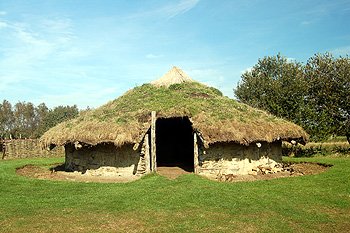Pegsdon Before 1086

A reconstruction of an Bronze Age round house at Flag Fen October 2011
The Bedfordshire Historic Environment Record [HER] contains information on the county's historic buildings and landscapes and summaries of each entry can now be found online as part of the Heritage Gateway website. One of the earliest pieces of evidence for settlement in the Pegsdon area is a polished greenstone Neolithic axe, found about 1880 [HER 407]. Also dating from the New Stone Age or, perhaps, the Bronze Age are a hammer stone and scraper found on Pirton Hills in 1941 [HER 415].
The Bronze Age is well represented. Two bowl barrows are extant near Pegsdon Common Farm. One lies east of the farm at Knocking Knoll the other, smaller specimen in Tingley Field Plantation. Bowl barrows may date from the late Neolithic right through the Bronze Age and mostly seem to date from about 2400 to about 1500 BC. They are mounds in which cremated human remains were buried, sometimes with a surrounding ditch. The barrow at Knocking Knoll is 30 metres in diameter and 3 metres high, a ditch used to surround it, now largely filled in. It was partially excavated by William Ransom on Hitchin [Hertfordshire] in 1856 and pottery was found. The barrow at Tingley Field is 20 metres in diameter and 3 metres high, again there used to be a surrounding ditch. There is no record of this barrow ever having been disturbed.
Aerial photography can show cropmarks in soil which reveal hidden features. Ring ditches are often so identified and are usually the remains of ploughed out barrows. A ring ditch was identified in 1976 south of the village [HER 9402] and another west of Pegsdon Common Farm in 1996 [HER 16760]. An incomplete bronze spearhead from the middle to late Bronze Age was found at Bury Farm whilst gardening [HER 18377].
The succeeding Iron Age has also yielded remains. Pottery sherds were found by field walking north-east of Pegsdon Common Farm [HER 16328]. A Roman quern, used for grinding corn, was also found in the area [HER 11315]. Some sites overlap periods, one such being north of Pegsdon Common [HER 1841]. Here a number of irregular enclosures have been identified as well as a circular enclosure with a central pit all clearly suggesting a farm. Pottery from Iron Age and Romano-British periods has been found as well as a late Iron Age mirror, two silver brooches. Part of this discovery was the breath-taking 127 gold coins deposited about 80 AD and now in Luton Museum.
A cemetery on Pegsdon Common [HER 413] seems to have begun in the Iron Age and extended into the Roman occupation It was discovered in 1879. Nearby an Anglo-Saxon burial was found, maybe coincidence or maybe a wish to be associated with a still-visible earlier cemetery.